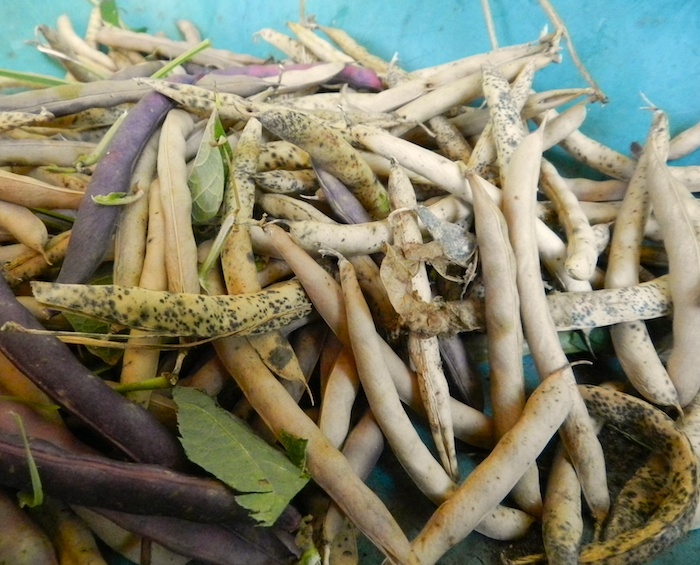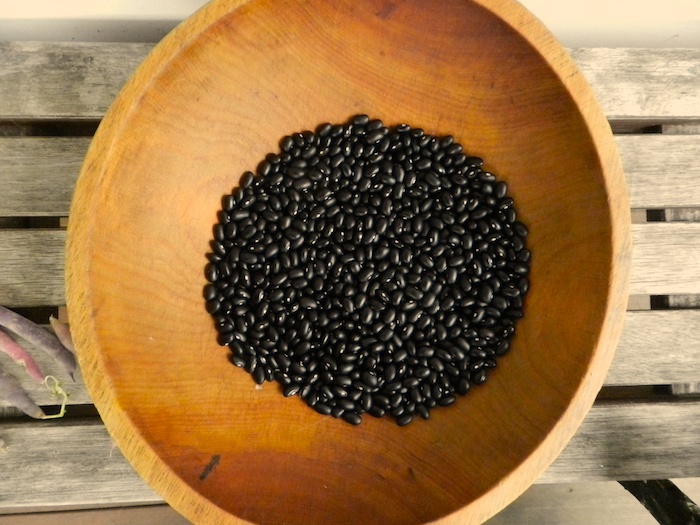I am not particularly adventurous when choosing plants for my vegetable garden. I tend to stick with the tried, true and easy that I know that my family will eat: tomatoes, green beans, lettuce, that sort of thing. Sure, I’ll try a new variety, or two, of tomatoes each year, but I rarely put in something that’s more outré, like kohlrabi. This year, though, I was given a packet a black turtle beans.
As a cook, who’s worked a lot with dried beans, I know that although they look like they’ll last forever, that actually, the texture and flavor of dried beans deteriorates over time. I’ve seen the difference in quality from local, recently harvested beans as compared to beans from a dusty bag found on a lower shelf at the supermarket. So, hoping that I could grow my own soup beans, and thinking that I didn’t have much to lose except for a small corner of my vegetable garden, I dedicated one tower trellis to black turtle beans. It turned out that growing dried beans was exactly like growing climbing green beans, except the pods are left on the vine to age, and to turn brown and spotted and crackle like old paper.
Inside were the most beautiful beans I’ve ever seen. Unlike ones I’ve purchased, these are glossy. They seem to glow. Perhaps that’s because they were shelled by hand. Perhaps it’s because they are so fresh. As I shelled them, I kept running my hand through the pile, scooping them up, and then letting them stream between my fingers, clattering back into the bowl.
However, what appears to be an abundant tower of twining vines, once harvested and threshed (a wonderful farming term for separating the shell from the bean) yields only a scant couple of cups of beans. This is what I have.
Beans are usually considered an inexpensive food, used for stretching a meal. But these are precious to me. I have enough to make one good-sized pot of soup. I’m already thinking about what will go into it and look forward to the first wintry day when a pot of black bean soup should be simmering on the stove. What would you add to the pot?




We just harvested our black soy beans which have 12 more percent protein that processed soy (like tofu). It’s a lot of work (3 rows yielded just over 5 spaghetti sauce jars full) Like you, I can’t keep my hands out of the bowl….what a feeling!
Black soy beans? Interesting! The nice thing about the turtle beans is they don’t take up much space on the trellis. I might grow them up on the fence line next year.
Terry are they organic? Next yearning may have to grow beans like that. Rob is Puerto Rican and Costa Rican so we eat our fill of beans, have tiu ever madenor tried “guyapinto” (sp.) It is great with eggs for breakfast
My garden is organic. I looked up the Costa Rican bean recipe and found this. I’ll try it!
It is GALLO PINTO
LOL it is so good, let me.know what you think… apparently it translates to spotted or painted rooster
I love tomato-based soups with lots of garlic, but back before I became a strict herbivore, there was nothing I loved better than a hearty beef stock….
Yes a pot of bean soup use to be a “poor mans” meal. Not any more.
The only pot of bean soup I’m good at is the ole smoked ham and beans with cornbread.
Looking forward to the results.
That close-up picture makes them look like jewels worthy of Cartier. Almost too pretty to eat. The gallo pinto sounds wonderful but I must admit I would be hard pressed not to toss in some cumin.
Jean try the recipe as is, then if you feel the need to add cumin do so… I think you may like it as is.. The true secret to it is a good cilantro….
I would add celery, tomatoes, onions for sure. I might use beef stock also. Did you ever read the story of Stone Soup? I will see if I can look it up and come back and tell you all where to find it. It was one of the most delightful stories when I was a child.
I always make Stone Soup! Take a couple of chicken bones, some onion skins, a few carrot and celery tops, throw them in a pot with some water and a bit of sage and thyme, bring it to a boil and then simmer for a while…voila! Chicken broth! It’s nice to turn nothing into something yummy.
I’ve made black bean and sweet potato soup that is so yummy! Can’t wait to hear what you come up with!
Do you think you will grow more next year? Enough for maybe 5 or 6 different dishes? They do look too beautiful to eat!
Gorgeous close up pic, such a pretty color. I just harvested 4 different varieties of dried beans yesterday and spent all afternoon shelling them. Am always amazed at the small amount of beans from such a big pile of pods. Enjoy your special soup, and hope you do a post about it!
Usually when I make soup, it tends to be everything but the kitchen sink type. The last time we had black bean soup, I “think” I used Bacon (chopped and fried crisp), onion, garlic, tomatoes, some green (mild) chilis or bell pepper, chicken broth, tomatoes (chopped canned ones with chilis), a touch of chili powder, cumin and probably some frozen whole kernel corn. We also like black beans, just stewed with onion, corn & cumin to accompany a Mexican dinner.
I LOVE black beans!! Yours are truly beautiful.
I always have this dilemma with a particularly wholesome food: how does it taste all by itself? Would it be wasting it by combining it with other flavors?
Having said that, I think I’d use those beans in an all-American veggie stew: onions, peppers, tomatoes, squash and corn. I once saw a recipe for such a stew which used smoked squash- I guess you would say “hot smoked”, in a metal container over a grill. Or one could throw in some dried chipotle for a nice smoky-hot.
-Such a lovely picture of the beans in the wooden bowl! I love wooden bowls, they seem like old friends in the kitchen…
I agree! I am and always have been a big fan of wood.x
oh – don’t eat them all. save some for next year’s crop and then next year, do it again and save some more and you will have your own heirloom beans!
Good job, Terry. The beans look delicious! And they remind me of the stone soup story, too.
1
Callo Pinto sounds good. I make black bean soup with similar ingredients, but no rice. I use chili powder, garlic and cumin. I use onion, celery, carrots and add fresh cut corn kernels toward the end of cooking time, and serve cilantro on the side. Progresso website has a recipe for Buona Sera Black Bean soup that I think is delicious.
Kaye’s answer above is pretty close to what I use. This year I planted Christmas Lima beans. They are a Pole bean. So gorgeous. Purple and white swirls. Everything I read said to let dry on vine so I did. They cook up a paler mauve but still retain the color. So good and beautiful.
I am with the bacon (best you can find-smoked) person. Now you if you were here in TN that would be “Benton’s)! I would also go with the tomatoes, onion, garlic, celery, corn, carrots, some chicken broth, and spice it up with the cumin, and chili powder. Simmer, simmer, simmer, and have a nice jalapeño cornbread at the ready for the finale. Maybe just a dollop of sour cream or Greek yogurt to top it off.
I haven’t heard of black turtle beans, however I have planted with success Black Magic and Shadow black beans. My soup ingredients would include garlic, onions, celery, carrots, vegetable broth, maybe some tomatoes,, basil and oregano, some cumin, either a chili pepper or some chili powder, a dash or two of tabasco, a handful of quinoa, and some chia seeds…oh, and the black beans.
Look up Purcell Mountain Farms for info about all beans including black turtle beans. They are different from other black beans and they are not “black soybeans”. They are used in Mexico and in the Southwest Usa. Also google “Stone Soup” to find several versions of the story.
I grew a couple of plants each of four kinds of beans this year, just for fun. The majority of the bean yield ended up being black beans – they were better producers than the other three plants. I still got maybe 1 1/2, 2 cups total beans. I’m saving mine till next year and planting more, then throwing them all together and making one big pot of soup. Probably with other stuff from the garden (tomatoes or maybe pumpkin, onions, bell peppers, herbs & spices, etc). I’ve got the beans put up fairly safely for now, and I’ll only need a handful to plant, so I should be able to save over a cup of them for next year’s soup. Hopefully we’ll have some of the other beans as well – tiger eye, jacob’s cattle, and Norwegian woman yellow. I’ll probably mix all the others with some veg into some sort of minestrone-style soup.
Terry, if you’ve never had beans and rice then you need to correct that as soon as possible. It is such a delicious and nutritious basic ‘peasant’ food common to so many cultures. Even without all the various spice and herb additions the combination of the two is really tasty. Don’t delay!
Terry, you just have to try kohlrabi. It’s so easy to grow, and so versatile. If I can grow it, anyone can, so you will have no problem at all. Oh, and I think it’s delicious!
The usual: onion, celery, lots of garlic, couple bay leaves, some large-cut carrots for color (maybe,) a pint of home-grown diced tomatoes (bragging here,) some red pepper flakes or a dried pepper from the garden. Then perhaps a chopped green pepper or a can of diced Mexican chilis, S&P, what else? Oh, a heaping T of ground cumin, at least, maybe two. Maybe some dried oregano. So many ways to do black bean soups! No oil, no dairy (although a topping of sour cream I do miss) and no dead animals. ;)
The beans are beautiful!
I brought back a couple handfuls of bean pods from Sigonella Sicily 15 years ago when my Naval Air squadron was stationed there; I bought them in the local farmer’s market, and they told me the dried-pod shelly beans were the same kind as the delicious edible-pod greenies they were selling. We have no idea what cultivar they are; we just call them “Chiclet Beans” since they are square and white when fresh. So I have been saving these seeds every year since then for the next year’s crop. I let the pods dry on the vine as you did, then string them on heavy thread and hang them from my kitchen passthrough; they don’t mold that way, and keep for years — we still have them, too, despite a couple crop failures. We cook more with the greenies than the shellies; they are the perfect length to put up in pints as dilly pickled beans.
I’m quite impressed that you’ve been able to save them, and that you’ve figured out how to use them in so many ways. I wonder if one of my readers could put a name to them?